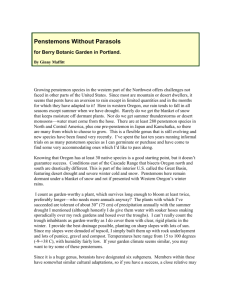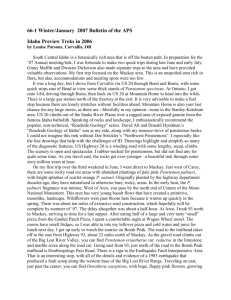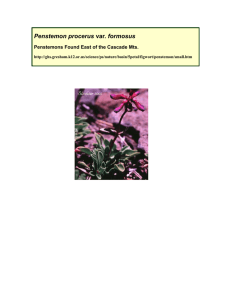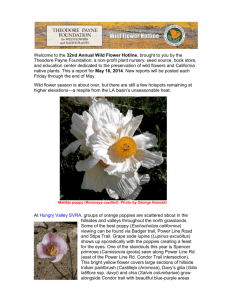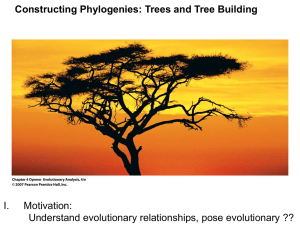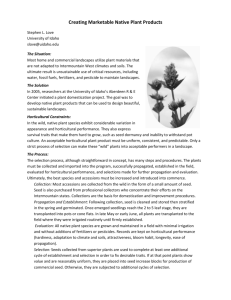Penstemon-L Archives - American Penstemon Society
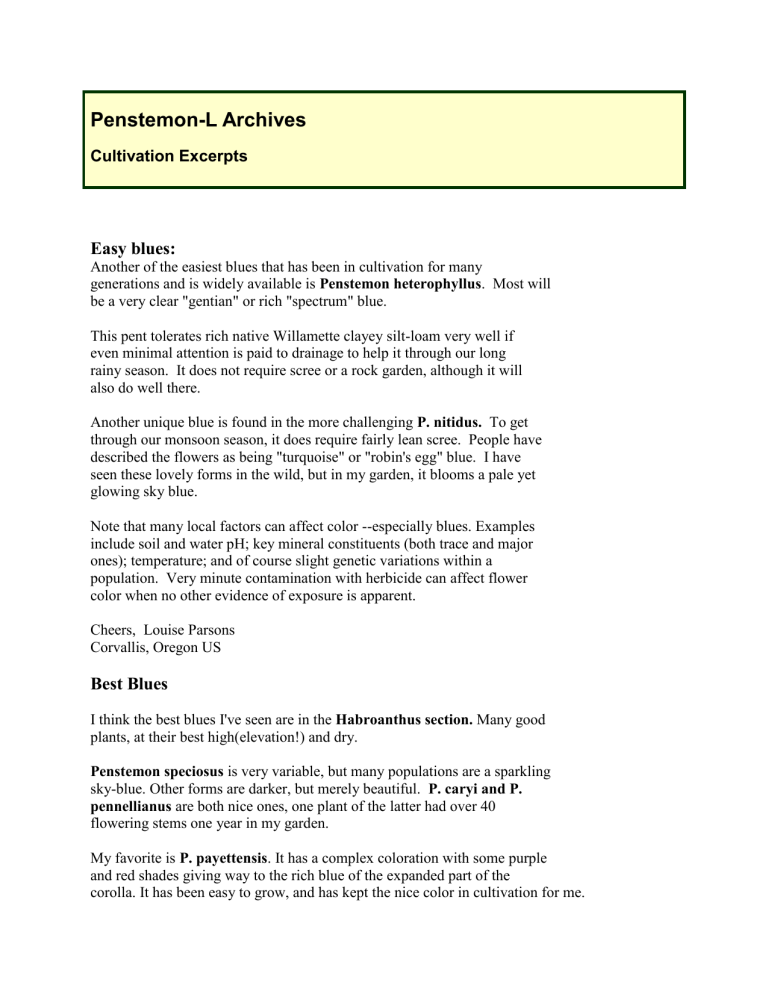
Penstemon-L Archives
Cultivation Excerpts
Easy blues:
Another of the easiest blues that has been in cultivation for many generations and is widely available is Penstemon heterophyllus . Most will be a very clear "gentian" or rich "spectrum" blue.
This pent tolerates rich native Willamette clayey silt-loam very well if even minimal attention is paid to drainage to help it through our long rainy season. It does not require scree or a rock garden, although it will also do well there.
Another unique blue is found in the more challenging P. nitidus. To get through our monsoon season, it does require fairly lean scree. People have described the flowers as being "turquoise" or "robin's egg" blue. I have seen these lovely forms in the wild, but in my garden, it blooms a pale yet glowing sky blue.
Note that many local factors can affect color --especially blues. Examples include soil and water pH; key mineral constituents (both trace and major ones); temperature; and of course slight genetic variations within a population. Very minute contamination with herbicide can affect flower color when no other evidence of exposure is apparent.
Cheers, Louise Parsons
Corvallis, Oregon US
Best Blues
I think the best blues I've seen are in the Habroanthus section.
Many good plants, at their best high(elevation!) and dry.
Penstemon speciosus is very variable, but many populations are a sparkling sky-blue. Other forms are darker, but merely beautiful. P. caryi and P. pennellianus are both nice ones, one plant of the latter had over 40 flowering stems one year in my garden.
My favorite is P. payettensis . It has a complex coloration with some purple and red shades giving way to the rich blue of the expanded part of the corolla. It has been easy to grow, and has kept the nice color in cultivation for me.
Found catalog -- What's good?
I just found a catalog on the internet that lists these penstemons for only $4 each. I can't judge them from the descriptions. Would any of these be good for a newcomer?
Penstemon aridua [aridus?] Trim rosettes and bright blue flowers. One of the best Penstemon for troughs
5x3" Big Horn
Penstemon barbatus Smallest of the species with
12" spikes bearing rose-red tubes Torrance
Penstemon carnosus Thick blue-green, glaucous rosettes bear several verticillasters of lavender-grape flowers 12x8
Emery Co.
Penstemon comarrhenus The flowers are beautifully colored with blue lobes, lavender throat, pink-violet tubes and a white palate with red-violet guidelines. Grows in open sagebrush flats with a loose pebbly soil.
12-2 Garfield Co. UT
Penstemon cyananthus Scintillating, bright blue flowers with a contrasting white lip and throat over smooth green leaves. Flowers over a long period 50x1 Utah
Penstemon cyathophorus Thick glaucous rosettes bear spikes with clasping leaves and several tightly-packed whorls of pale lavender-pink to bluish-pink flowers. Exquisitely beautiful. 12x8 Jackson
Penstemon davidsoniii v. praeteritus Dense, deep blue-green leaf mounds resemble a hebe. Large lavender flowers 8x10" cult/E. OR
Penstemon globosus showy large, bright blue flowers ¾’’ long rosette of basal leaves May to
August 10-1 central
Penstemon hallii Tufts of linear foliage clumps of violet dragons hovering on short stems. Classic miniature alpine.
9x7c Park Co.
Penstemon heterodoxus Forms a mat of oblanceolate,
2
somewhat linear leaves with rose-purple flowers
3-10" CA.,
NV
Penstemon heterodoxus v. heterodxus Small mats are covered with 2" pinwheel-shaped heads of 1", deep purple flowers. One of the best dwarf Penstemon. Silty soils on stony volcanic slopes slightly moist from snow melt No. Sierra
Penstemon humilus Tufts of bluish-green leaves create small compact mats. Luminous dark blue flowers are in compact whorls on 4-6" stems. Dry rocky subalpine ridges Yakima Co.
Penstemon jamesii foliage is pubescent, leaves can be wavy-toothed and linear or oblanceolate.
Lavender to purple-blue flowers CO
Penstemon janishiae Narrow lavender pink flowers on 3" stalks having dusty-hairy leaves Xeric or warm scree
Penstemon laevis
Penstemon leiophyllus Leaves are smooth and linear-oblanceolate, basal leaves are not well developed. Usually blue-violet and whitish 2’ West
Penstemon linarioides 12x1
Penstemon linarioides v. sileri A nice compact spreading mat of prostrate woody branches with much shorter upright stems, 4-6" in flower spreading mats to
24". Very Harmony
Penstemon nanus Unbelievably tiny on its native habitat of dry limestone slopes, becoming only slightly larger in cultivation. Small gray leaves, blue flower clusters. 2x4c Millard Co.
Penstemon newberryi v. newberryi Compact form 4" in leaf with a 1-2’ spread Intense rose-red to deep rose-violet flowers have contrasting white-hairy throats in 4" racemes covering evergreen, mounds of foliage
W-facing rocky ledges in gravely soils derived from metavolcanic substrates No Sierra
Penstemon ophianthus
¾" chubby flowers in
3
congested 4-6" spikes. Flowers are lavender-violet with densely white-bearded palate, yellow bearded staminodes and dark violet guide-lines on all the lobes. The narrow, sticky gray-green leaves are basally disposed in small tufts from a branching caudex. Loose gravely alluvial soils.
Pinyon/juniper with sagebrush Garfield Co. UT
Penstemon pachyphyllus v. congestus Thick gray-green leaves, intense blue-violet spikes 35x1
Emery Co. UT
Penstemon parryi Narrow lanceolate, bluish, glaucous leaves clasping the stem. Flowers are brilliant rosy pink 4’ AZ.
Mex
Penstemon procerus Small bright blue flowers tiered in dense clumps over flat green rosettes
Likes a little more moisture than some of its kin Sheridan
Penstemon rydbergii deep indigo-blue flowers 10"
WY to N>
Penstemon serrulatus subshrub with relatively large serrated, glabrous leaves. Deep blue to dark purple flowers
8-28" Silver Star
Penstemon sp. Nice red basial folage with blue flowers on 10" stems
Penstemon sp. Small tuffs 2"x3" with blue flowers
City Of Rocks Id
Penstemon strictus Several spires pf large bright blue flowers in early summer. Xeric 60x2 cult
Penstemon virens Glossy deep green mats, racemes of deep blue 20x1 Elbert Co.
Penstemon virgatus v. arizonicus Pale violet flowers 18" se AZ
Penstemon wardii Endemic to Arapine Shale substrates near Salina Utah. Grayish, pubescent tufts bear several spikes-like panicles with relatively large flowers of clear violet-blue. 14x6 Sevier Co.
Penstemon whippleanus Whorls of deep purple, almost black flowers 26x1 Summit co.
Penstemon x mexicali Compact mounds of narrow, lustrous green leaves covered with rich blue-violet flowers all
4
summer 12x1
The nursery homepage is: http://www.grablesalpines.com/index.html
Note: I went to this site, but found no nursery listings at all.
BSL
Diana Pederson, Ingham County, Michigan, Zone 5
5
Penstemon grahamii
Graham Nicholls, British author of "Alpine Plants of North America" (Timber
Press, 2002) grows P. grahamii splendidly in pots. He has provided beautiful pictures in his book (P. 196 and 197). Graham is a favorite NARGS speaker who visited Oregon chapters on tours and dazzled us with his growing expertise and
~gorgeous photos. Graham notes that the penstemon is ~not named after him, but is one of his favorites nonetheless :-)
Fortunately he also has a website at: http://members.aol.com/graplant/
He has a separate picture site, with more photos of P. grahmii in cultivation: http://www.picturetrail.com/gallery/view?p=999&gid=192650&uid=111231
Note that Graham favors generous pots or troughs in his wet-winter climate.
Many of his penstemons are grown in an alpine house where he can control moisture. An alpine house has another advantage in that can provide additional spring and summer warmth in climates that are otherwise on the cool side for penstemons.
Just a quick look, but I notice that Alplains (www.alplains.com) is offering P. grahamii in their new catalog. Personally I can't offer them a good home here and now, but believe that conscientious propagation is a form of conservation.
If you are fortunate and can grow such treasures, be sure to share seed.
Louise Parsons, Former president of the American Penstemon Society
Corvallis, Oregon
Northwest Native Seed Catalog Offerings
Some of the highlights of the catalog:
Three varieties of P. angustifolius. Maybe be difficult in wet-winter climates.
P. azureus , gorgeous blue, and even if it is from California, completely hardy.
P. bracteatus , a rare rhizomatous dwarf species in Section Glabri.
P. tusharensis , under the name P. caespitosus var. suffruticosus .
P. centranthifolius . Two selections of P. comarrhenus.
P. compactus , a dwarf in the P. cyananthus polymorph I've been longing to grow in my garden.
P. cyanocaulis . This species has blue stems, nice blue flowers, and peculiar wavy-margined leaves. Small enough for a trough.
P. glaber ssp. brandegei (according to Flora of the Great Plains). No relation to P. glaber in my opinion.
All plants labeled " P. alpinus, not an alpine plant "(which P. glaber var. alpinus most certainly is) sold in New Mexican nurseries are this species, which should be called P. brandegei, an utterly distinct, huge, gorgeous, long- and huge-flowered and long-lived plant.
P. griffinii and P. inflatus.
Supposedly distinct taxa in the P. oliganthus complex. Things to grow and decide for yourself.
P. leiophyllus var. francisci-pennellii.
One of the all-time great rock garden penstemons.
6
7
P. leonardii, and its var higginsii. This is one of the most difficult penstemons to germinate, but worth the trouble.
P. goodrichii and P. marcusii.
Corolla lobes more like azaleas than penstemons; not showy, but different.
P. labrosus.
From San Bernardino Mtns in California; very similar to P. rostriflorus but with anthers indehiscent at the connective. Seedlings (2 cm tall) were hardy in my garden, without snow cover, to -22C.
Three varieties of P. rostriflorus.
A late-blooming, red-flowered saccanthera penstemon.
P. scariosus.
Beautiful sky blue flowers, seems to be pretty easy to grow.
P. speciosus ssp. kennedyi.
A beautiful dwarf form of P. speciosus, stays dwarf in cultivation.
P. subglaber . Beautiful, beautiful, deep, deep blue flowers.
P. thompsoniae . A wonderful, silver-leafed dwarf for the garden; an upright version of P. caespitosus var. desertipicti. Caught the eye of Dwight Ripley on a trek through Utah with
Rupert Barneby during World War 2. Ripley was one of the most astute observers of rock garden plants, and a wonderful writer, too.
P. utahensis . He knows it's red. Most texts claim this species is blue, which it isn't.
P. venustus.
Our plants this year were smothered with hundreds of large blue violet flowers; one of the great species for the garden.
P. watsonii. Very blue. Not necessarily a dryland plant, so fairly easy to grow.
Bob Nold
Author of “Penstemons” Timber Press
Soils, and pH
Paige wrote:
>of the ones from alkaline territory in both alkaline and acid soil, and
>found that they survive in both. Dare we imagine that Penstemons are pretty
>darned adaptable?
One person's opinion, but yes as far as generalities can be made, I think that pents are especially adaptable to pH ranges.
For Diane and any others that are new to penstemon, I think that providing excellent drainage and holding back on excess summer water is very important. Sand beds are an excellent choice for many dryland plants that would otherwise do poorly in summer rain or high humidity. Dianthus do wonderfully in them too.
However...a caveat....especially applicable to those living in mid-continental areas......
Check with your local extension soils person, university, or Natural
Resources Conservation Service office (formerly Soil Conservation Service) about adding sand though. At one of these places a soils report for your area is available. There are some areas of the country where there is fierce adhesion between certain types of feldspar ( a common mineral) in
sand and certain local clays. The adhesion can be worsened with watering and cultivation and you can wind up with concrete. A high-silica sand helps to avoid this problem. In some cases, the addition of even a small amount of organic matter may also help. Again depending upon your local clay and sand mineralology, the addition of gypsum can either help or worsen your problem, so locally-tailored advice is extremely important. Worms will eventually mix some of the clay soil into the sand.
I am also wondering exactly what you mean by "topsoil". Here in Corvallis
Oregon that means very sandy river loam which grows many pents quite well because it is relatively lean and a good mineral soil with little organic matter.
In the drier west those big hybrids that I use for the border and for hummingbird food do need some summer water, but we have a pronounced summer drought. Incidentally Diane, pents also make wonderful container plants if you use good drainage. I am in the middle of a renovation project and moved many of mine to containers and they are doing great. Some of the big hybrids and taller species are growing in half-barrels along with lilies that I also had to move unexpectedly.
…and yes, the hummingbirds are definitely feeding on rupicola.
I have seen this in the High Country and thought that I was dreaming <grin>.
Louise Parsons, former president of the American Penstemon Society
Rare and Endangered Species: Saving rare varieties
This a good discussion on a topic that I've been thinking about for some time now. The Center for Plant Conservation has a seed collection and storage program that operates through its member botanical gardens. It focused on endangered species - you can see what has been enrolled if you go to their main page and click on the
'National Collection' link - you can search their registry. This, of course, is a formal program which emphasizes a protocol that ensures that a broad sample of the genetic diversity within a population is collected and stored long-term. The Royal Botanic Garden, Kew, has the Millennium Seed Project which focuses more broadly.
In our gardens, though we may grow species that are quite rare in nature, unless we have collected the seed ourselves we seldom have specific information on the source of the material or any sense of how much of the population it represents much less the range of variability within the species. Even if you keep good records on the
8
source of your seed, its unlikely that you would have such answers.
For this reason, the scientific community tends not to consider the existence of a plant in the horticultural trade as lending much conservation value.
While I consider such concerns legitimate, I believe that we as gardeners can make a significant contribution to conservation beyond advocacy and our horticultural knowledge and skills. One need only consider the potential fate of our rare plants in light of many of the scenarios of global climate change. Those plants restricted to mountain tops or specific substrates, as are many of our rare penstemons, will likely have no where to go unless they manage to persist in suitable refugia. One implication of this is that any genetic material in cultivation is of value regardless of its representativeness when the alternative is the loss of the species.
Few would dismiss the conservation value of Franklinia altamaha in gardens worldwide even if we knew for certain that it represented only a fraction of its original genome.
Nevertheless, questions regarding the provenance of specific plant material and its representativeness cannot be dismissed as merely academic. The internet offers many possibilities for tracking of our seed collections. Perhaps APS could undertake some type of voluntary registry that integrates with its seed exchange.
Just one idea, and I'd like to hear others.
Steve Caicco
Reno, NV
Bob, good that you have pointed this out. There is one question on
> Barbara's questionnaire asking something like should the
> APS should start a committee with a goal of looking into and saving
> rare populations. Other than asking people on the annual tour not
> to collect anything on the tour, I don't think I've seen any
> commentary from APS about the subject. I heard from someone in
> NARGS the other day who had done 'some seed colllecting for that
> exchange while in Glacial NP'! Obviously, we have a ways to go on
> the subject. I see road-building encroaching on sensitive
> populations here also (know of only one area where P. ovatus grows
> outside of Gifford N Forest, and have never spotted it there). I
> would like to see that the general meeting in Idaho discusses this
> topic.
> Ginny Maffitt
9
10
>
Subject: saving rare varieties
>
> The subject of the day seems to be whether or not the feds will
> protect grahamii or not, or whether we can or ought to protect it.
> The subject is proper for the APS (American Penstemon Society) to
> weigh in upon, yet I am not aware that we have ever had a
> conservation chair or committee. One could argue that our society
> could stay above the political fray, but it seems that advocacy for
> the protection of the object of our society is a worthwhile
> endeavor. There may be a method of extending this protection
> through careful growing, and I would suggest that we encourage our
> botanic gardens to extend their Penstemon selections, especially as
> regards "T&E" species; further I would think that we might
> encourage our members to look into the National Collections program
> used in the UK. Perhaps one of our members from Great Britain could
> explain the program to us, so that we could evaluate whether it
> might be an avenue for us to explore as a method of keeping the
> rare gene pools alive and thriving.
>
> Have a GREAT GREEN NEW YEAR, Bob Pennington former president of the American
Penstemon Society
Rock Garden penstemons
Bob Llewelyn wrote:
> I would like to plant some of the dwarfer types in rockeries, screes and troughs. So far P humilis, P procerus, P procerus var Tolmeii, P heterophyllus, P montanus, P davidsonii and P newberryi look likely candidates. The latter 3 also look a bit shrubby. Can someone please confirm or otherwise that these are suitable for rockeries or are there other, perhaps more suitable, species and/or varieties I should be seeking.
Reply
There are about 300 species of Penstemon. I would guess that 100 of these are small enough to be suitable for the rock garden. I recommend the book Penstemons by Bob Nold to give you an almost complete list of all of the penstemons, together with size, cultivation requirements, and ornamental qualities. Other ones I would suggest include P. nitidus, P. eriantherus, P. arenicola and P. jamesii.
One consideration in choosing is the amount of sun and dryness you can provide. Most of the ones you listed can survive in a somewhat cloudy climate. Ones I listed may require more sun than what you can provide. Ones which grow in clay in Colorado ( rainfall of 10 - 15") might require a sand/gravel bed or an under eaves site to limit the root moisture in your climate.
Iza Goroff
Whitewater Wisconsin zone 4b
Original message: Edaphic Endemics
> I am very interested in those species of Penstemon that are adapted to a
> particular soil type (we call them edaphic endemics in science lingo).
> Do you or anyone else out there have a list of these species? Aside from P.
> penlandii, I am familiar with P. debilis and P. haydenii - if you count
> sand blowouts in that category.
> Off the top of my head, no. I think P. grahamii is one, as far as I know
> endemic only to oil shale; maybe P. arenarius (sand) , P. albomarginatus
> (sand), P. gibbensii (Green River shale), P. idahoensis . Must be others.
> P. versicolor , which I remain convinced is distinct from P. secundiflorus , is
> confined, as far as I know, to Carlile shale in southern Colorado and maybe
> northern New Mexico.
> There is a superb article by Jim Archibald in A Century of Alpines (quoted
> in my bibliography) about endemic plants of the western US. Maybe a case
> could be made for most of these being edaphic endemics.
One more you can add to this list is Penstemon clutei which grows here near
Flagstaff. It is not a listed species but is rare enough to be on the Forest
Service's Sensitive Species list. Outside of cultivation, it only occurs on the cinder hills east and north of town.
Bob Wilson
Flagstaff, AZ
Reply #1:
From an ecological perspective, it is often the case that plants that move on to marginal soils are not good competitors on better soils. Thus, when you put an edaphic in the common garden, it may perform very well in cultivation. Plants that have adapted to the marginal soil to the point of obligate edaphic endemic, will do better in their altered soil.
My student colleague who worked on P. debilis found that it grew best in the oil shale she brought back to the greenhouse rather than in regular soils. I'll have to reread her thesis to see how extensive her experiments were.
Here's a start on a list of edaphic endemics - or at least species that seem to be restricted to a particular soil type. Please send along other candidates. I'll start looking at distributions and other info in the literature as I'm compiling the list.
P. debilis
11
P. distans
P. clutei
P. pseudoputus
P. albormarginatus
P. oklahomensis
P. nudfloris
P. dissectus
P. penlandii
P. haydenii
Cheers - Andi
*****************
Andrea D. Wolfe
Assistant Professor http://www.biosci.ohio-state.edu/~awolfe/
Reply
Andi,
You should, definitely add P. idahoensis to the list. This species occurs only in very specific layers of tuffacious ash--and nowhere else. From my observations, the entire population occurs in a 30 sq. mile radius. The plants of this species in my garden only seem to thrive in substrate imported from the site.
Jim Hatchett, Eagle, Idaho Zone
Shade
an astonishingly large list of penstemons that tolerate shade. The one that especially surprises me is the mention of P. thompsoniae .
Now this I seriously doubt. P. thompsoniae is, in effect, a desert or semi-desert plant that, here, anyway, prefers full sun. (Denver has the light intensity, in calories received, of Cairo.)
"Tolerate" is a pretty ambiguous word in horticulture, and what it usually seems to mean is that plants grow but don't thrive. There are very few plants anywhere in the world that will grow equally well in sun or shade, despite what nursery catalogs claim. ("Shade" is also extremely ambiguous, of course. Very few penstemons in my garden perform as well in shade as they do in sun, so, naturally, I'm doubtful of suggestions of shade-tolerance in much less sunny climates.)
...
> Nothochelone nemorosa ( a very close? pent relative) grows in shade if the
> soil is gritty and well-drained.
Close relative. At one time called Penstemon nemorosus. The specific epithet
12
means "of woodlands", so it would probably do well in a shady area.
> Close relatives P. rydbergii and P. euglaucus seek partial shade from the
> afternoon sun and hot summer winds from the west.
In Colorado, P. rydbergii grows in full blazing sun in constantly-wet soil.
In wet swales along highways, etc. I'd agree that most of the proceri tolerate some shade, P. procerus var. tolmiei does well here in an increasingly-shady rock garden (although it does get about half a day's worth of sun).
P. whippleanus is reputed, locally, to be a penstemon that prefers shade.
The plants, in nature, grow in full sun almost at timberline. In shade (like on Pikes Peak) the plants are mostly dwarfed, with fewer flowers.
Bob
Saccanthera
Bill and Cathy King wrote:
> Hi, The Nevada National Heritage Program list Penstemon rhizomatosus as an
> endemic penstemon from White Pine Co. at 10,000 to 11,250 feet. Does anyone
> out there have the citation for its publication, or more exact location or
> other further information about this species?
Bill, Penstemon rhizomatosus N. H. Holmgren is a newly-described small-flowered species in Section Saccanthera. Its closest relative is the larger-flowered P. kingii ( any relation, speaking of relatives?) and P. tiehmii , described in the same paper cited below. The type locality is given as south of the top of Cave
Mountain in the Schell Creek Range in White Pine County, Nevada.
The citation is: Holmgren, Noel H., Two new species of Penstemon
(Scrophulariaceae: sect. Saccanthera) from Nevada, U.S.A. Brittonia 50 (2),
1998, pp.159-164.
Bob
R. Nold, Lakewood, Colorado
13
